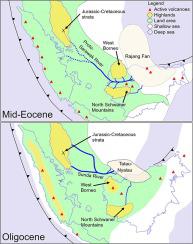Journal of Asian Earth Sciences ( IF 2.7 ) Pub Date : 2021-06-30 , DOI: 10.1016/j.jseaes.2021.104876 Long Xiang Quek , Tung-Yi Lee , Azman A. Ghani , Yu-Ming Lai , Muhammad Hatta Roselee , Hao-Yang Lee , Yoshiyuki Iizuka , Yu-Ling Lin , Meng-Wan Yeh , Muhammad Amiruddin Amran , Rezal Rahmat

|
Although Peninsular Malaysia abundant Permo-Triassic Malayan granitic plutons and volcanics (292–198 Ma) generate an enormous volume of detrital zircons that masks other detrital sources in fluvial sediments, there are suggestions that Peninsular Malaysia could recycle detrital zircons from Indochina (through Jurassic-Cretaceous strata) to other parts of Sundaland by paleoriver after the Indochina-Sundaland sediment link diminishes in the Cenozoic. As there is insufficient data to prove this, we compiled our new detrital zircon U-Pb isotopic data from modern river sands in Peninsular Malaysia with all available data to create a dataset that revealed five detrital zircon age pattern zones: (1) Northeast Coastal Zone (~73 Ma and ~223 Ma), (2) Mid-East Coastal Zone (~236 Ma and ~280 Ma), (3) Southeast Coastal Zone (~170 Ma, ~243 Ma, ~291 Ma, 400–416 Ma and 1545–1852 Ma), (4) Central Zone (~220 Ma) and (5) Mid-West Coastal Zone (~227 Ma and 1105–1173 Ma). All detrital age pattern zones show a clear detrital contribution from Malayan granitoids and volcanics. However, the Southeast Coastal Zone also shows significant contributions from Jurassic-Cretaceous strata in the northwest, e.g. Bertangga and Gerek sandstones, making them comparable with sources from Indochina and Lower Cretaceous strata in Singapore. We suggest a defunct drainage during Paleogene which transports the eroded sediments from the Jurassic-Cretaceous strata in the northwest to the sink in the southeast coast of Peninsular Malaysia recycled “Indochina signature” detrital zircons. If the sink connects with the Sundaland paleoriver system, it might contribute to the “Indochina signature” detrital provenance in West Borneo.
中文翻译:

在马来西亚半岛河流沉积物中追踪来自印度支那的碎屑特征:碎屑锆石可能再循环到西婆罗洲新生代沉积物中
尽管马来西亚半岛丰富的二叠纪-三叠纪马来亚花岗岩岩体和火山岩(292-198 Ma)产生大量碎屑锆石,掩盖了河流沉积物中的其他碎屑源,但有人建议马来西亚半岛可以回收来自印度支那(通过侏罗纪-白垩纪地层)在新生代印度支那 - 巽他大陆沉积联系减少后由古河流到巽他大陆的其他部分。由于没有足够的数据来证明这一点,我们从马来西亚半岛现代河砂中汇编了我们新的碎屑锆石 U-Pb 同位素数据和所有可用数据,以创建一个数据集,揭示了五个碎屑锆石年龄模式区:(1) 东北沿海地区(~73 Ma 和 ~223 Ma), (2) 中东沿海地区 (~236 Ma 和 ~280 Ma), (3) 东南沿海地区 (~170 Ma, ~243 Ma, ~291 Ma, 400–416 Ma 和 1545–1852 Ma),(4) 中央区 (~220 Ma) 和 (5) 中西部沿海区 (~227 Ma 和 1105–1173 Ma)。所有碎屑年龄模式区都显示出来自马来亚花岗岩和火山岩的明显碎屑贡献。然而,东南沿海地区也显示出西北部侏罗系-白垩系地层的显着贡献,例如 Bertangga 和 Gerek 砂岩,使其与新加坡的印度支那和下白垩统地层的来源具有可比性。我们建议在古近纪期间有一个废弃的排水系统,它将西北侏罗纪-白垩纪地层的侵蚀沉积物输送到马来西亚半岛东南海岸的汇,回收“印度支那特征”碎屑锆石。如果水槽与巽他大陆古生物系统相连,











































 京公网安备 11010802027423号
京公网安备 11010802027423号